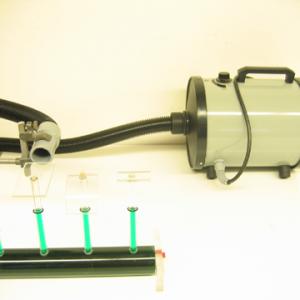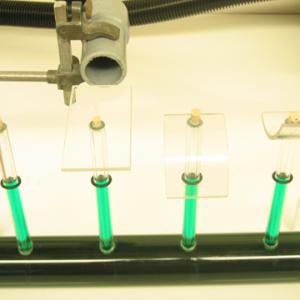College of Liberal Arts & Sciences
2C20.07 - Bernoulli's Principle - ????
Place the outlet of the vacuum blower at the proper height so that 4 surface configurations of the entrainment apparatus can be moved under it as desired. Observe how the water will move upward in the tube without a surface attached, will show no movement in the tube with the flat surface, will move upward in the tube with the downward curve, and will move downward in the tube with the upward curve.
- Panagiotis Koumaras and Georgios Primerakis, "Flawed Applications of Bernoulli's Principle", TPT, Vol. 56, #4, Apr. 2018, p. 235.
- Martin Kamela, "Kamela's Response", TPT, Vol. 46, # 3, March 2008, p. 134.
- Peter Eastwell, "Thinking Some More About Bernoulli", TPT, Vol. 46, # 3, March 2008, p. 134.
- Martin Kamela, "Thinking About Bernoulli", TPT, Vol. 45, # 6, Sept. 2007, p. 379.
- Albert A. Bartlett, "The Curious Case of the Well-Behaved Shower Curtain", TPT, Vol. 34, #7, Oct. 1996, p. 444.
- Daniel Engber, "Why Do Shower Curtains Billow Inward?", Popular Science, Vol. 288, #2, Mar/Apr. 2016, p. 94.
- Peter H. Eastwell, "Bernoulli? Perhaps, But What About Viscosity?", Science Time Education, Vol. 6, #1, 2007, p. 1.
- Evan Jones, "Is Pressure Really Lower in a Moving Fluid?", Sierra College, 2009.
- Clifford Bettis, "The Coanda Effect and Bernoulli's Principal", Colloquium Talk, University of Nebraska Lincoln, 2009.
- Clifford Bettis, "To a Man with a Hammer...", Colloquium Talk, University of Nebraska Lincoln, 2009.
- Curt Suplee, "Taking Bernoulli for a Ride", Everyday Science Explained, National Geographic, p. 54 - 55.
- Julius Sumner Miller, Q152 & A152, Millergrams II – Some More Enchanting Questions for Enquiring Minds, p. 32 & 90.
Disclaimer: These demonstrations are provided only for illustrative use by persons affiliated with The University of Iowa and only under the direction of a trained instructor or physicist. The University of Iowa is not responsible for demonstrations performed by those using their own equipment or who choose to use this reference material for their own purpose. The demonstrations included here are within the public domain and can be found in materials contained in libraries, bookstores, and through electronic sources. Performing all or any portion of any of these demonstrations, with or without revisions not depicted here entails inherent risks. These risks include, without limitation, bodily injury (and possibly death), including risks to health that may be temporary or permanent and that may exacerbate a pre-existing medical condition; and property loss or damage. Anyone performing any part of these demonstrations, even with revisions, knowingly and voluntarily assumes all risks associated with them.

